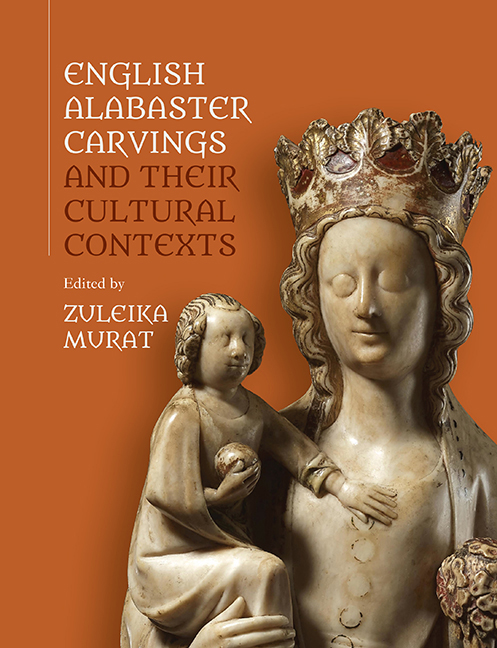Book contents
- Frontmatter
- CONTENTS
- List of Illustrations
- Acknowledgements
- List of Contributors
- Introduction
- 1 ‘Burton-Upon-Trent, Not Nottingham.’ the Evolving Study Of Medieval English Alabaster Sculpture
- 2 Stone to Ensure Victory and to Generate Friendships. On The Meaning of Alabaster
- 3 Contextualising English Alabasters in the Material Culture of the Medieval Mediterranean
- 4 English Alabaster Images As Recipients of Music in the Long Fifteenth Century: English Sacred Traditions in a European Perspective
- 5 Contextualising Alabasters in Their Immersive Environment. The ‘Ancona D'Allabastro Di Diverse Figure’ of the Novalesa Abbey: Meaning and Function
- 6 Alabaster Carvings in Late-Medieval Lincolnshire
- 7 ‘Tabernacles, Howsynges and Other Things’. Three Alabasters From the Burrell Collection in Context
- 8 Conservation Study of Three Alabaster Carvings From the Burrell Collection, Glasgow Museums
- 9 ‘Smooth as Monumental Alabaster’. the Alabaster Tomb Industry in England 1550–1660
- 10 Merchants’ Tombs in Alabaster
- 11 Exploring Alice: the Theological, Socio-Historical, and Anatomical Context of the De La Pole Cadaver Sculpture
- Bibliography
- Index
- Already Published
Introduction
Published online by Cambridge University Press: 14 September 2019
- Frontmatter
- CONTENTS
- List of Illustrations
- Acknowledgements
- List of Contributors
- Introduction
- 1 ‘Burton-Upon-Trent, Not Nottingham.’ the Evolving Study Of Medieval English Alabaster Sculpture
- 2 Stone to Ensure Victory and to Generate Friendships. On The Meaning of Alabaster
- 3 Contextualising English Alabasters in the Material Culture of the Medieval Mediterranean
- 4 English Alabaster Images As Recipients of Music in the Long Fifteenth Century: English Sacred Traditions in a European Perspective
- 5 Contextualising Alabasters in Their Immersive Environment. The ‘Ancona D'Allabastro Di Diverse Figure’ of the Novalesa Abbey: Meaning and Function
- 6 Alabaster Carvings in Late-Medieval Lincolnshire
- 7 ‘Tabernacles, Howsynges and Other Things’. Three Alabasters From the Burrell Collection in Context
- 8 Conservation Study of Three Alabaster Carvings From the Burrell Collection, Glasgow Museums
- 9 ‘Smooth as Monumental Alabaster’. the Alabaster Tomb Industry in England 1550–1660
- 10 Merchants’ Tombs in Alabaster
- 11 Exploring Alice: the Theological, Socio-Historical, and Anatomical Context of the De La Pole Cadaver Sculpture
- Bibliography
- Index
- Already Published
Summary
English alabasters played a seminal role in the artistic development of late medieval and early modern Europe. The production of alabaster was one of the main industrial activities in medieval England. The numerous alabaster workshops, often family run, were engaged in many different kinds of highly specialised work: both the extraction and working of the stone, sculpting reliefs that were then completed with polychrome finishes and gilding, as well as the sale of both the raw material and the finished products. Alabaster was mined and worked in England as early as the twelfth century. Initially it was used mainly as a material for sculpting funerary monuments and architectural features, but from the late 1300s onwards it was also used to produce sculpture in the round at various scales, destined for the furnishing of altars or to be placed on church screens. Even more widespread came to be the carved reliefs in a rectangular format that, when mounted in sequence, formed monumental altarpieces. During this same period, works in alabaster began to be exported on a large scale, produced in England and then sold in France, northern Germany, Ireland, Italy, Spain and Portugal. The industry continued to flourish until the Reformation, when the practice of iconoclasm signalled the end of the production of sacred images in English territory.
This book is about those alabaster sculptures. Naturally, it is not the first publication to focus on this type of object; indeed, if anyone were to scan the complete list of previous studies on alabasters, they would be amazed at the incredible number of publications on the subject that have accumulated from the late eighteenth century onwards, with a decisive upturn in the course of the last century. This book furthers that tradition, while also aiming to investigate the origin, history and context – broadly intended as social, cultural, intellectual and devotional context – of these works of art from several novel points of view. Some of these new approaches may at first appear divergent to the reader, but the idea is that they will offer a complementary and stimulating overview of the subject.
- Type
- Chapter
- Information
- Publisher: Boydell & BrewerPrint publication year: 2019



